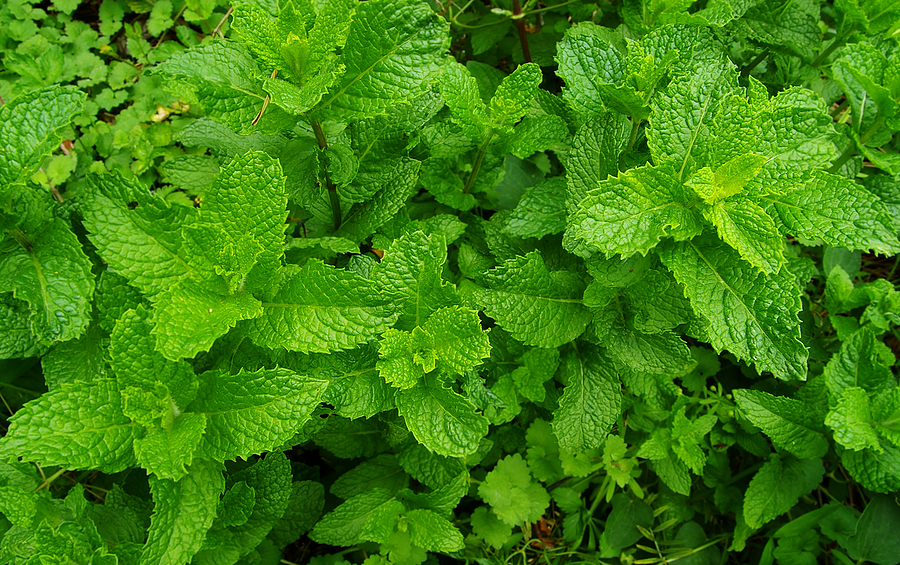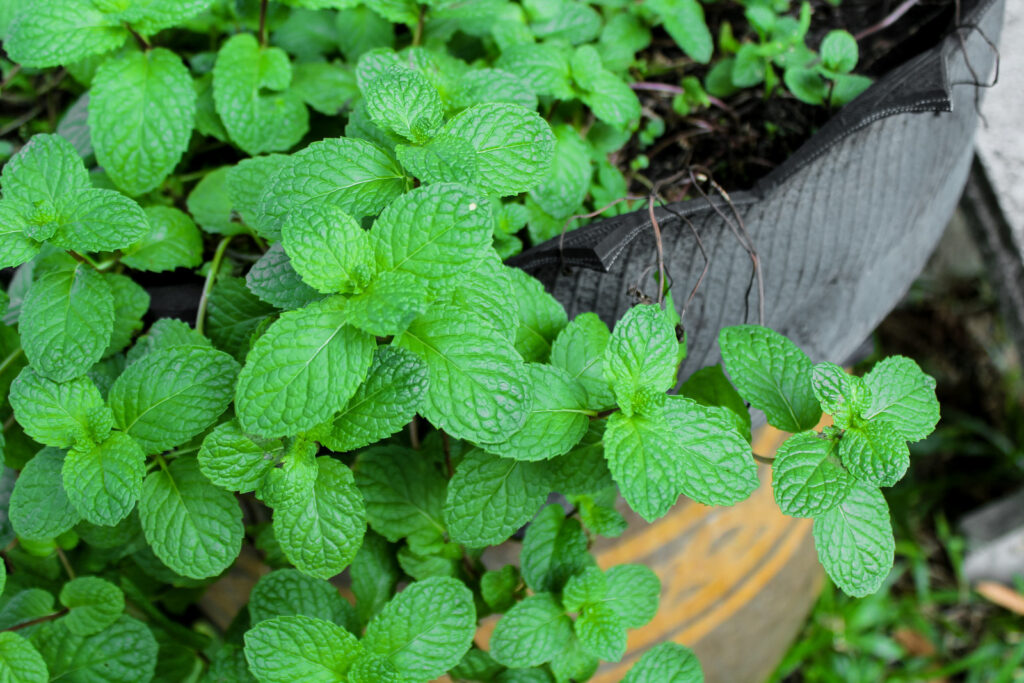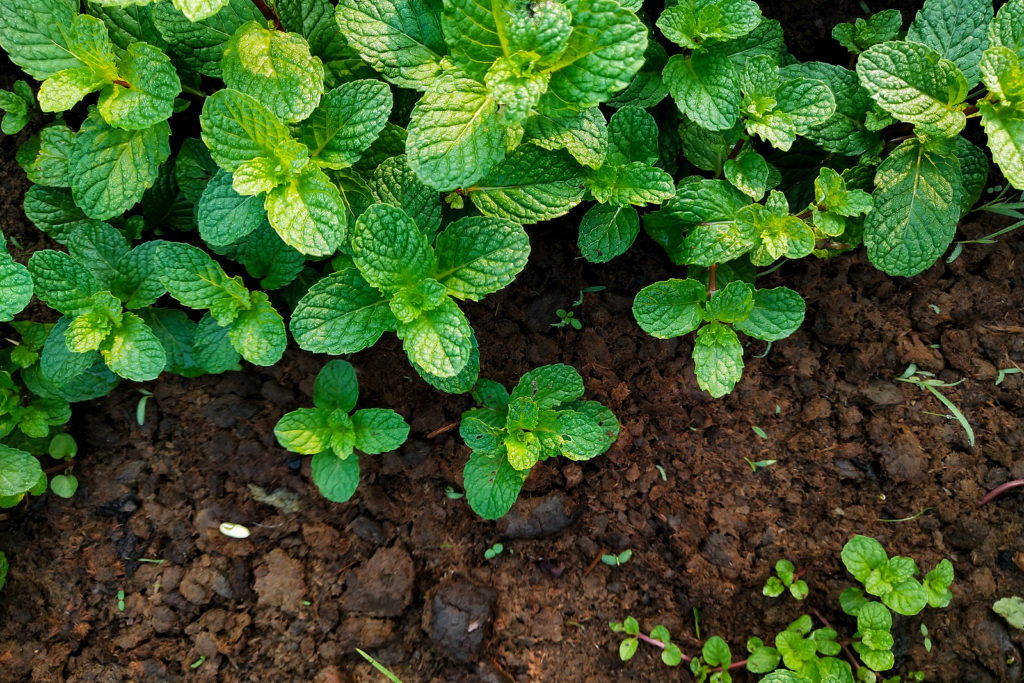Use mint fresh or dried to flavor vegetables—cabbage, carrots, cucumbers, eggplants, peas, potatoes, tomatoes, and zucchini. You can add fresh mint to cold and hot soups and beverages.
There are all types of mint to choose from spearmint, peppermint, pineapple mint, orange bergamot, and apple mint to name a few. Mint has a striking aroma, a sweet warm flavor, and a cool aftertaste.
Growing your own mint is not difficult. You can sow mint in the garden or in a small container to sit in the kitchen window. If a neighbor or friend has mint, anytime after the last spring frost is a good time to take a stem cutting or division and get it started. From seed, mint is ready to use in about eight weeks.
Mint is one of the most popular herbs. There are many mints for the gardener and cook to choose from spearmint, peppermint, apple mint, pennyroyal, lemon mint, pineapple mint, and ginger mint to name a few. Cooks prefer spearmint for most savory dishes; it’s less overpowering than other mints such as peppermint which is very strong flavored with a strong menthol aroma. Mint leaves are used in teas, cold drinks, salads, and vegetables, and, of course, mint is a favorite served with peas and lamb.
Articles of interest:
- How to Grow Herbs
- How to Start an Herb Garden
- Best Herbs for Container Growing
- Herbs for Cool Season Growing
- Grow 20 Herbs for Cooking
Here is your complete guide to growing mint.
Where to plant mint
Mint prefers full sun but will grow just fine in partial shade. Mint prefers temperatures between 55 and 70°F (13–21ºC). If you live in a cold-winter region, protect mint through the winter in a container placed under a covered patio, in the garage, or in the kitchen.
- Best location: Plant mint in filtered shade or partial shade; mint will tolerate full sun but it’s best to avoid hot, direct sun.
- Soil. Grow mint in moist, well-drained soil. A container is great for growing mint since mint will spread via its roots and can take over a garden if not controlled.
- Soil preparation: Mint grows best in loamy and moist but well-drained soil. Do not add too much-aged compost or aged manure to the area where mint grows; high fertility can leave mint susceptible to rust. Mint prefers a soil pH of 6.0 to 7.0.

When to plant mint
- Seed starting indoors: Start mint from seed indoors in spring 3 to 4 weeks before the last frost. Mint seeds can be slow to germinate. Start mint in flats under fluorescent lights. Note: mint seed does not always grow true to the parent. Sowing store-bought seeds will ensure you grow the variety you want.
- Transplanting to the garden: Set mint seedlings in the garden two or more weeks after the last frost in spring. Grow mint from divisions or cuttings started in cool weather, spring or fall. You can also plant store-bought seedlings in spring or fall.
- Outdoor planting time: Sow seed outdoors in early spring. Plants started from division or layering can be planted in the garden from spring to fall.
How to plant mint
Sow mint seed at a depth of ¼ inch (6 mm). Mint seed germinates in 7 to 10 days. The best time to start divisions is before spring growth starts. After spring and the weather warms, root stem-tip cuttings in water or moist soil will be most successful. You can divide mint again in the fall.
- Planting depth: Sow seed ¼ to ½ inch deep. Grow mint in bottomless containers set into the ground; this will keep roots and stems from running into other parts of the garden.
- Spacing: Space plants 12 to 18 inches apart or more; mint spreads quickly.
- How much to plant: Plant one or two mints for cooking. Grow 8 to 12 plants for tea and preserving. A variety of mints can be grown in separate containers.
Mint companion plants
- Companion planting: Plant mint with asparagus, carrots, celery, cucumbers, onions, parsley, peppers, and tomatoes. Do not plant mint in the same container as other herbs; it can choke out other plants. The sharp fragrance of mint repels insect pests; the flowers attract beneficial insects. Mint is said to improve the vigor and flavor of cabbage and tomatoes. Unchecked mint can be very invasive; plant it in pots and set the pots near the plants you want to protect. Place saucers beneath the pots so the roots do no escape.
Watering and feeding mint
- Watering: Don’t let mint dry out; keep the soil moist but not wet. Water mint regularly and evenly. Mint prefers moist soil. If grown in dry soil mint will spread less rapidly.
- Feeding: Feed mint at planting time and again in mid-summer with compost tea or a dilute solution of fish emulsion. Top-dress mint with an inch or more of compost or well-rotted manure in fall. Mint is a light feeder; its nitrogen, phosphorus, and potassium needs are low. Top-dress your mint bed with compost or well-rotted manure in autumn. Spray mint with liquid seaweed extract a couple of times during the growing season.
Mint care and maintenance
- Care: Mint can be invasive; it spreads rapidly by shallow, underground runners. Contain mint within metal strips set 10 inches into the soil or bottomless containers 10 inches deep sunk into the ground. Dig out old plants after five years and start anew.
- Pruning: Keep mint pinched back for fuller growth; prune back the top half of the plant in late spring and mid-summer. Cut woody stems back to encourage succulent growth. Avoid letting flowers bloom; flowering will decrease the oil content of leaves. Removing flowers will also prevent cross-pollination. Thin clumps for good air circulation to prevent root and foliage disease. Cut back and replant mints every two to three years. If not cut back, mint can become woody.

Container growing mint
- Container growing: Mint can be container grown as an annual. Choose a container at least 8 to 10 inches deep. Divide and repot container-grown mints every year to keep them healthy.
- Winter growing: Cut mint back to the ground in late autumn and put mulch on top to protect crowns and roots from winter cold.
Mint pests and diseases
- Aphids, mealybugs, and spider mites can attack mint; spray these away with a strong blast of water or spray them with insecticidal soap. Control aphids and mites that find your mint with a strong spray of water or with a botanical insecticidal soap; use a floating row cover to exclude beetles and caterpillars.
Mint diseases
- Mints are susceptible to verticillium wilt, mildew, and mint rust. Avoid overhead watering which can leave plants susceptible to fungal diseases. Remove diseased or dead stems and leaves from the bed before winter. Replant the roots in a different spot. Mint rust is a fungal disease—the lower leaves will be speckled with orange; destroy the infected leaves and replant the roots in another spot. To prevent root and foliage diseases such as rust, thin crowded clumps of mint to ensure good air circulation.
How to harvest mint
- When to harvest: Pick mint leaves and sprigs as you need them throughout the growing season. Cutaway flower stalks before they bloom for a sweeter taste. Cut the entire plant down to 2 or 3 inches above the soil at midseason and it will regrow for a second harvest.
- How to harvest: Use a snip or scissors to cut off the top leaves and tips of branches or pinch off individual leaves for fresh use. For drying, cut stems 4 to 6 inches above the soil surface.
Mint in the kitchen
Mint will grow to maturity and is ready for harvest about 60 days after sowing. Cut top, tender fresh leaves as needed. To dry, cut stalks just before blooming then hang them in bunches to dry. Store fresh mint air-tight containers or dry or freeze them.
- Flavor and aroma: Mint has a sweet, slightly hot flavor, and a cool aftertaste. Mint has a strong menthol aroma.
- Leaves: Add freshly chopped mint leaves to leafy green salads, fruit salads, or pasta salads.
- Add mint to cooked peas, steamed potatoes, and carrots. Add a tablespoon of minced mint to cooked rice just before serving. Add mint to veal, eggplant, beans, fruit salads, beverages, creamy vegetables, soups, and sauces. Serve mint leaves with peas and lamb. Use leaves to flavor drinks, jellies, candy, chocolate, and desserts. Add spearmint to steamed carrots or new potatoes. Add apple mint and pineapple mint to drinks, fruit salads, cottage cheese, and cream cheeses.
- Teas: Use mint to flavor teas. Add a sprig of mint to a pitcher of lemonade to create a refreshing drink
- Culinary companions: Mint is a complement to cilantro, lemon verbena, oregano, and rosemary. Mint will complement the flavors of meat, fish, and vegetable dishes.
Preserving and storing mint
- Refrigeration: Wrap mint in a damp paper towel and store it in a perforated plastic bag in the refrigerator crisper where it will keep for two or three days.
- Drying: Dry stems upside down in a warm, shady place; let stems dry for 2 to 5 days then strip dried leaves to be stored in an airtight jar. Leaves also can be dried in a dehydrator. Mint holds its fragrance and flavor when dried.
- Freezing: Freeze mint leaves in a plastic bag. Freeze leaves in ice cubes for later use. Freeze 6 to 8-inch sprigs. Crumble frozen mint into cookie dough for minty cookies.
- Storing: Store dried mint leaves in an airtight jar.

Mint propagation
- Seed: Mint seed does not always grow true to its parent. Cuttings, division, and layering are better propagation alternatives.
- Cuttings: Root stem cutting in water. You can also cut a runner into sections several inches long then place the cuttings in moist, sterile growers mix and set in a sunny spot to root.
- Division: Divide plants and roots by slicing the plant or roots in half with a spade. Get new divisions started in cool, not hot weather.
- Layering: Cover the nodes of runners (stolons) with soil to root new plants. Rooted runners are easy to divide and plant separately.
Mint varieties to grow
There are more than 600 species and cultivars of mint; here are popular cultivars:
- Spearmint (Mentha spicata): dark green toothed leaves are slightly smaller than those of peppermint with a crinkly look and feel; the plant grows to 2 feet high; use fresh or dried to flavor food. This is the most popular mint for culinary use.
- Peppermint (Mentha piperita): the plant grows to 3 feet high and has strongly scented dark green toothed and pointed leaves to 3 inches long with purple flowers. Leaves give a cooling sensation in the mouth and throat; use to flavor sweets; intense sharp-minty flavor; use to flavor candies and desserts and to make hot or cold tea, cordials, and liqueurs or as a garnish for punch or fruit.
- Apple mint (M. suaveolens): smells of mint and ripe apple with good flavor; best shredded; stiff stems that grow 20 to 30 inches high; round, green-gray leaves 1 to 4 inches long are slightly hairy; purplish-white flowers on 3-inch spikes.
- Basil mint (M. x piperita citrate ‘Basil’): spicy scent with light notes of basil. Good with eggplant, tomatoes, and zucchini.
- Bowles’ mint (M. x villosa f. alopecuroides): use for all dishes requiring mint; fine flavor; leaves should be chopped finely to eliminate furry texture.
- Black peppermint (M. x piperita piperita): use as peppermint, pungent aroma.
- Chinese mint (M. arvensis ssp. haplocalyx): use to flavor tea.
- Chocolate mint (M. x piperita citrate ‘Chocolate’): the scent of after-dinner chocolate mints; good for chocolate desserts and as a garnish for ice cream and sorbets.
- Corsican mint (M. requienii): strong peppermint scent when crushed; a small creeping plant that grows about 1 inch high; round leaves are slightly hairy and gray-green, about 1 to 4 inches long; purple-white flowers.
- Curly mint (M. spicata ‘Crispata’): flavor similar to spearmint; use in most culinary dishes; this is a low-growing groundcover that is quite aromatic.
- Field mint (M. arvensis): aromatic but mildly flavored with high menthol content; used in Southeast-Asian cooking. Also called “wild mint” which was used by Native Americans in baking fish.
- Ginger mint (M. x gentilis ‘Variegata’): a hint of ginger to mint flavor; delicate warm mint; use in salads and tomato dishes. Also called Scotch mint.
- Golden apple mint (M.x gracilis): spicy apple fragrance; use to flavor foods; smooth, deep green leaves variegated with yellow; the plant grows to 2 feet tall; use leaves to flavor foods.
- Horsemint ( M.longifolia): oval, hairy leaves; aromatic.
- Japanese mint (M. arvensis piperescens): dark green leaves; flowers used to delicately flavor tea. Called English mint in Japan.
- Large-leafed horse mint (M. longifolia): musty, minty scent; use in Indian chutneys and Afghan cooking. Also called Buddleia mint.
- Lemon mint (M. x piperita citrata): refreshing minty lemon scent; use in mint sauce or fruit dishes.
- Moroccan mint (M. spicata ‘Moroccan’): spicy aroma, less sweet than spearmint; use in teas and minted dishes.
- Mountain mint (Pycnanthemum pilosa): not a true mint; smells and tastes like mint but slightly bitter; young leaves and buds used as a mint substitute.
- Orange bergamot mint (M. x citrata): grows to about 2 feet tall and wide and has dark green, 2-inch leaves that are edged with purple; they taste and smell slightly or oranges; flowers are lavender growing in dense spikes.
- Orange mint (M. x peperita citrata): orange flavor; use to flavor teas and fruit dishes; the scent has also been described eau de cologne, lemon, bergamot, and lavender.
- Pennyroyal (M. pulegium): low grower with downy, oval leaves that are not more than ½ inch long; small, rosy lilac flowers bloom in late summer and fall; leaves can be toxic in large amounts; very strong peppermint scent and flavor; use sparingly; use in mint sauce and as a substitute for peppermint in sorbets. Do not use it when pregnant or if suffering from kidney disease.
- Pineapple mint (M. suaveolens ‘Variegata’): pineapple fragrance when young; young leaves have a tropical fruit aroma; older leaves are mintier. Use young leaves to flavor salads, cool drinks, and fruit desserts.
- Tashkent mint (M. spicata ‘Tahskent’): intense aroma and flavor; use as spearmint.
- Water mint ( aquatic): round to oval leaves; strop peppermint fragrance; scent can vary from musty to strong peppermint.
Get to know mint
- Botanical name and family: Mentha species. There are many varieties of mint. Peppermint (Mentha piperita) and spearmint ( Mentha spicata) are the best known. See other mint varieties below. All are members of the Lamiaceae—mint family.
- Origin: Europe
- Type of plant: Herbaceous perennial
- Growing season: Summer
- Growing zones: Zones 5 to 9
- Hardiness: Mint is cold hardy to -20°F and easily withstand frost. Mint can be grown in cold winter climates but it is best over-wintered in a sheltered place or indoors. Mint can tolerate high humidity.
- Plant form and size: Mint generally grows upright 1 to 3 feet tall, though a few grow much shorter. Mint stems easily root when they touch the ground so mint can be invasive.
- Flowers: Whorls of small white, lavender, or purple blossoms on terminal spikes.
- Bloom time: Bloom mid-summer to fall.
- Leaves: Dark green, creased, round to oval leaves pointed at the tips grow opposite one another on four-sided stems.
Also of interest:
- Anise
- Anise Hyssop
- Arugula
- Basil
- Bay
- Bee Balm
- Borage
- Calendula
- Caraway
- Catnip
- Chamomile
- Chervil
- Chives
- Cilantro-Coriander
- Clary
- Costmary
- Cress
- Dill
- Fennel, Sweet
- Horseradish
- Hyssop
- Lavender
- Lemon Balm
- Lemongrass
- Lemon Verbena
- Lovage
- Marjoram
- Mint
- Nasturtium
- Oregano
- Parsley
- Perilla
- Rosemary
- Sage
- Salad Burnet
- Savory
- Scented Geranium
- Shiso
- Sorrel
- Stevia
- Sweet Cicely
- Tarragon
- Thyme
Related articles:
Best Herbs for Container Growing
Planning the Home Fruit Garden
Garden Planning Books at Amazon:
- Vegetable Garden Almanac & Planner
- Kitchen Garden Grower’s Guide Vegetable Encyclopedia
- Vegetable Garden Grower’s Guide
- Tomato Grower’s Answer Book



